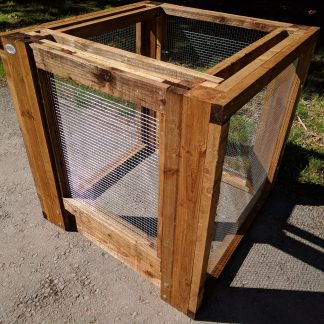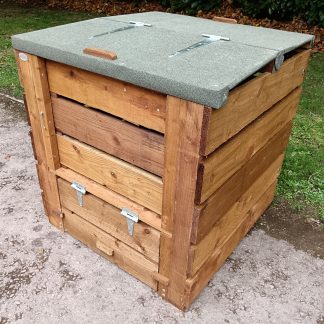How to make good compost in a Compost Bin.
To make compost in a compost bin, we suggest filling the Compost System by making the heap inside the bin with a mixture of nitrogen-rich material (such as grass clippings, vegetable peelings) and carbon-rich material (such as bark, fibrous material or shredded paper); a good ratio is 1:2. At the base place a layer of twiggy material, and then ideally build up the heap in 15cm (6″) layers If possible avoid too much grass clippings or leaves, as air movement is inhibited. Clippings from prunings may be used, although it is advisable to shred woody stems first. Compost only young weeds. Weeds with seed, or those about to set seed, should preferably be burned, as should all pernicious and perennial weeds.
A high temperature can be produced during the making of compost, which encourages the natural breakdown of organic matter and it also helps to kill weed seeds and some pests and diseases. For a compost heap to heat up sufficiently it should be at least 1 cubic metre (1 cubic yard) in size, but preferably the larger the better, although a garden rarely produces this quantity all at once. In two or three weeks the compost reaches its maximum temperature and in about three months it is mature. Turning the heap speeds up the process and ensures complete breakdown of material. If there is an ammonia odour this indicates that the compost is too rich in nitrogen, and if the heap lacks air there will be a smell of rotten eggs. Invariably there will be some material that will not breakdown fully and this material can be composted again. Use the compost when the rate of breakdown of the organic matter has levelled off. At this stage, it should be crumbly, dark and sweet smelling.



The Benefits Achieved By Composting
Here we have a list of the Ten Basic Benefits achieved by composting:
- Composting Reduces The Demand For Landfill Sites. Apart from being offensive and unsightly, especially for people living nearby, landfill sites are expensive and have to be paid for either by industry or local council taxpayers. They produce unpleasant odours despite the greatest efforts of the managers to avoid them and can release greenhouse gases like methane.
- Compost Improves Soil Structure. Both water holding capacity and fertility are improved by adding humus to sandy soil, whilst heavy clay soils gain improved structure and porosity.
- Compost Helps Suppress Disease. Various scientific studies show that the addition of helpful micro-organisms present in the compost help plants to fight disease and some of the effects are quite dramatic. Work done at the University of California (1994-2000) highlighted the suppression of Brown Rot in Peaches, End Rot in Onions and Avocado Root Rot.
- Compost Reduces The Need For Pesticides. Tests have shown up to 90% reduction in Whitefly and complete elimination of Aphids and Red Spider Mite. It is believed, that this is because the compost activates natural plant repellents.
- Compost Reduces The Need For Artificial Fertilisers. By providing natural growth promotion, NPK fertilisers are less necessary. In agriculture the run-off of fertilisers into water courses are also reduced, as nutrients from compost are less likely to leach out.
- Compost Reduces Costs. The need to purchase soil improvers, composts and artificial fertilisers is reduced.
- Compost Suppresses Weeds. When used as a mulch, a layer of compost will help suppress weeds by reducing the amount of available light. Properly made compost will not contain weed seeds while providing soil nutrients. Uncomposted mulches e.g. woodchip or bark can reduce nitrogen levels in the soil and cause damage to plants. However, compost used slightly before it is mature is extremely valuable for Vermiculture.
- Compost Helps To Preserve Peat Stocks. It is regularly reported that peat stocks are approaching extinction with current levels being down to 4%. Whatever the figure is, it is undoubtedly a finite resource and replacement products have been found wanting. In this regard, a ‘Gardening Which’ report (Jan/Feb 2001) shows germination of Impatiens (Busy Lizzies) seeds in peat free or reduced peat compost is down to a minimum of 30% compared to minimum 54% in peat based material. Correctly made, natural compost does not suffer this deficiency.
- Compost Enables Organic Horticulture. Although there is a need to take care that no substances banned by the Soil Association are included in waste to be composted, properly made compost is the very basis of organic horti/agriculture.
- Compost Can Eliminate Digging. Compost used as mulch will be dragged into the soil by earthworms and this helps with soil aeration as well as providing the required nutrients. In shrubby borders, it can remove the need to dig.
COMPOSTING AND BIO-DIVERSITY
Composting is a great way to encourage both greenery and wild life into the local environment. Compost used as a mulch on borders is packed full of life. It is a habitat for worms, insects and all sorts of other invertebrates that are the food source for insect-eating birds. It is particularly invaluable during the winter months when the ground is hard with frost. The material itself is full of nutrients that feed plant life. This plant life provides food and shelter for birds and insects; both directly in the form of seed and fruit and indirectly when it is turned into compost and used as a mulch.
Stag Beetle. The UK’s largest ground-living beetle can be found in woods, parks and gardens. Stag beetle larvae live off dead wood. The more decaying wood that there is around, the more places there are available for female stag beetles to lay their eggs. Occasionally, stag beetle larvae may be found in compost heaps. Shredded woody stems of plants can be used as a mulch on plant borders.









